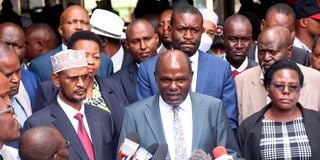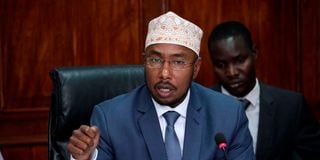Premium
Storm brewing over review of constituency boundaries

Former Independent Electoral and Boundaries Commission (IEBC) Chairman Wafula Chebukati addressing journalists at Anniversary Towers, Nairobi on April 26, 2022. The commission is supposed to carry out a review of boundaries before March 2024.
What you need to know:
- The country’s next major political task after the General Election — boundary review — has stalled because of a dysfunctional electoral commission, a dispute over a secret crucial document and supremacy wars between rival political formations.
- A periodic review of constituency boundaries is necessary to keep up with population growth to accommodate new constituencies for populous units.
- This will in turn guarantee equitable representation and fair distribution of resources such as constituency funds.
The country’s next major political task after the General Election — boundary review — has stalled because of a dysfunctional electoral commission, a dispute over a secret crucial document and supremacy wars between rival political formations.
A periodic review of constituency boundaries is necessary to keep up with population growth to accommodate new constituencies for populous units. This will in turn guarantee equitable representation and fair distribution of resources such as constituency funds.
It’s at the heart of the one-man-one-shilling campaign, particularly by leaders from populous regions, who argue their vote-rich areas are under-represented in Parliament. They claim this undermines allocations to their regions, funds that ideally should be spent on grassroots development, including school bursaries.
The creation of new electoral units was initially planned prior to last August’s elections, but tight deadlines ruled out the exercise, prompting the polls body to resort to the last constitutionally imposed timeline that is now fast approaching without substantial progress.
And it has emerged the country is hurtling towards a constitutional crisis because the exercise could ultimately trigger an amendment to the Constitution — and a referendum, a showdown that ruling coalition figures are reluctant to sanction in the current volatile political situation.
There are pointers that the number of constituencies, currently capped by the Constitution at 290, will most likely be affected given the surge in population has pushed the population quota to 164,015, up from 133,000 that informed the 290 constituencies in 2010.
Population quota is the figure obtained after dividing Kenya’s 2019 population of 47,564,296 by the number of constituencies.
Considering the lower population quota had put at least 27 constituencies at risk of abolishment — they were only retained on the basis of a transitional clause reached as a political settlement — the latest higher population average would affect even more electoral units, or occasion substantial movement of constituents after redrawn boundaries.
Periodic review
The Constitution provides for a periodic review of the names and boundaries of constituencies at intervals of not less than eight years, and not more than 12 years.
With the last review in March 2012, the Independent Electoral and Boundaries Commission (IEBC) is expected to have ensured validation of boundaries for electoral units on course to meet the March 2024 deadline, but this is yet to happen.
Sources told Nation at one point there was a stalemate between the electoral commission and the Kenya National Bureau of Statistics (KNBS) over validating boundaries for electoral units.
This is the reason Volume V of the 2019 Kenya Population and Housing Census which details population by constituency and ward has never been made public. Efforts by the Nation to obtain the report have been futile as KNBS and IEBC officials have been evasive.
With this report having worked out a population quota, one can project the number of constituencies that merit splitting and those that would have to be abolished/merged after reviewing of boundaries to meet the minimum threshold.
“Unfortunately we cannot release the same without clear boundaries,” an official of KNBS told Nation when asked about the report detailing population figures by constituency and ward.
In official reports, IEBC has acknowledged “unresolved constituency and ward boundary disputes (are) likely to affect the forthcoming delimitation process.”
Boundary conflicts
Unresolved boundary conflicts are among the threats the commission identifies in its strategic plan for 2020-2024.
Yesterday, the commission's chief executive Marjan Hussein acknowledged delays in the validation of the information but blamed it on the absence of electoral commissioners.

IEBC chief executive Marjan Hussein Marjan.
“Geo data has been collected for all 47 counties and the same mapped already. Validation of this information has not been done yet and will await the recruitment of new commissioners. Once this is done then it will be followed by public hearings, reporting and resolution of disputes arising from boundary delimitation,” said Mr Hussein.
KNBS only released four volumes of the 2019 Kenya Population and Housing Census namely, the distribution of the population by county and sub-county, by administrative units (county, sub-county, division, location and sub-location), by age, sex and administrative units, and by socio-economic characteristics.
During the last review in March 2012, some 27 constituencies that were below the population quota were spared through a political settlement given the boundary report must be approved by Parliament and no MP would vote themselves out of a job.
And the MPs have taken sides in the political brinkmanship set to derail the exercise that informs representation and sharing out of resources through constituency funds, and which often draws protests of gerrymandering that even mar presidential elections.
Already the opposition has sounded the alarm over the plans for the delimitation as the deadline fast approaches.
National Assembly minority leader Opiyo Wandayi yesterday told Nation that Kenyans have been kept in the dark with regard to the goings-on at the IEBC concerning boundaries review.
“We had demanded that the Chebukati team should not commence the exercise since their term was coming to an end. Our position still remains that such a sensitive exercise should only be undertaken by a fully independent commission which enjoys the confidence of all political formations,” said Mr Wandayi.
Resistance
Yesterday, the Azimio la Umoja One Kenya official insisted that until a commission of that kind is in place, “any attempts to initiate and execute the process will face stiff resistance from the people”.

National Assembly Minority Leader Opiyo Wandayi. He said that Kenyans have been kept in the dark with regard to the goings-on at the IEBC concerning boundaries review.
Senate majority whip Boni Khalwale warned that even though the timelines for the delimitation process had not been breached, Kenyans should not expect additional electoral units anytime soon unless the IEBC is fully set up and there is a constitutional review through a popular initiative.
“Majority of people are looking forward to having their constituencies divided with the forthcoming review of boundaries, but what they don’t know is that you can never subtract or increase the number of constituencies in Kenya from 290 without the amendment of the Constitution,” Dr Khalwale said.
“IEBC in its mandate is not expected to initiate constitutional amendments, but to operate within the provisions of the current Constitution which fixes the number of constituencies at 290,” he added.
Dr Khalwale went on: “The only thing that will happen is that the names and boundaries of wards will be changed, and the boundaries of constituencies will be tweaked because the Constitution contemplates a situation whereby populations of constituencies will, as much as possible, come closer to the constitutional population quota.”
He pointed out that from the foregoing, what is expected is that a ward or a fraction of a ward or a location within a ward, could be shifted from one ward to the other or from one constituency to another to approach that quota.
Makueni Senator Dan Maanzo said that Kenyans should expect zero additional constituencies “since we have an unpopular government that fears a referendum which has to take place before additional constituencies can be realised beyond the current 290 as per the Constitution”.
“There must be a referendum to change boundaries or increase constituencies. And with a government that wants a shortcut in legislation by buying MPs to get a two-thirds majority, so that they can amend the Constitution on the floor of the House, it may not be tenable,” said Mr Maanzo.
The Kenya Kwanza government, he claimed, is avoiding a referendum and, therefore, even if IEBC is fully constituted, nothing would change.
But Dr Khalwale cautioned: “If people are forgetting, they should see the frustration and pain that (former president) Uhuru went through when he tried to push BBI.”
The Kakamega senator was referring to the Building Bridges Initiative to amend the Constitution to, among others, create an additional 70 constituencies that were thwarted by the Supreme Court.
Shifted goalposts
Perhaps it’s these controversies that explain why IEBC has shifted goalposts as to the date the process would begin, and to what scale.
Initially, Mr Chebukati had stated the commission would commence a review of the constituency and ward boundaries as of March 2020 and complete it by July 2021 — at least one year before the General Election for the new boundaries to take effect.
However, the commission later ruled out the practicability of having new electoral units on time for last year’s elections.
On June 9, 2020, responding to reports of alleged boundary delimitation in Mandera county, IEBC in a press statement said the next review would be done by 2024.
In June 2021, Mr Chebukati told senators the process would start in April 2021 and end in February 2024.
“Why is there such a discrepancy and large timelines between what you should’ve completed in April 2021 and now so that you can convince Kenyans why we cannot have new constituencies by the time of the elections,” Senator Mutula Kilonzo Junior, now Makueni governor, then pressed Mr Chebukati.






